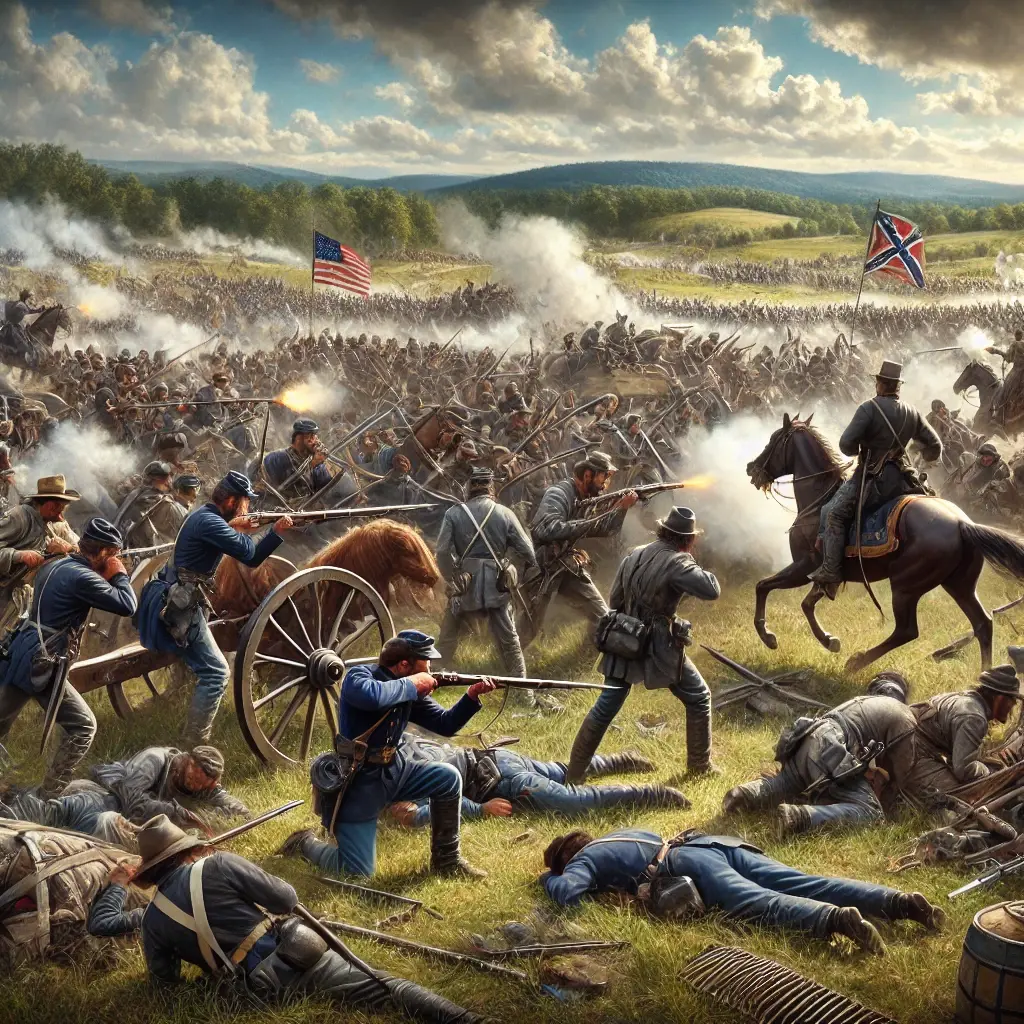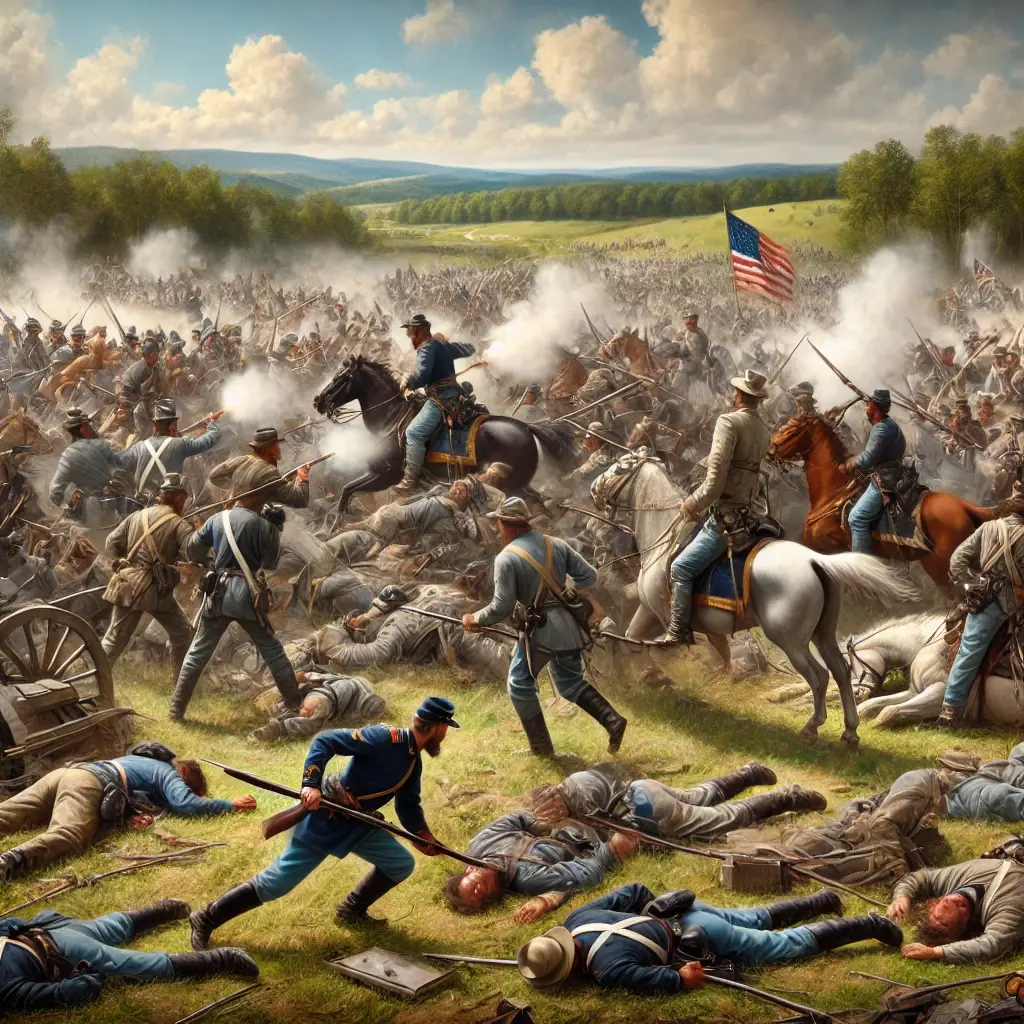The First Battle of Bull Run, also known as the First Battle of Manassas, took place on July 21, 1861. It was the first major battle of the American Civil War, occurring near Manassas, Virginia. This battle shattered the North’s hopes of winning the war quickly and easily, proving that the conflict would be longer and more brutal than initially anticipated. The battle also highlighted the importance of better preparation and leadership, influencing subsequent military engagements during the war.

In the months leading up to the battle, both the Union and the Confederacy were eager to secure a decisive victory that would demonstrate their strength and resolve. The Union forces, under the command of Brigadier General Irvin McDowell, were tasked with marching from Washington, D.C., to seize the strategic railroad junction at Manassas. This move aimed to disrupt Confederate supply lines and open a path to the Confederate capital of Richmond, Virginia.
On the Confederate side, Generals P.G.T. Beauregard and Joseph E. Johnston commanded a combined force that included soldiers from various Southern states. Their strategy focused on defending the vital railway junction and repelling the Union advance. The Confederates were well aware of the importance of the upcoming battle and the impact it would have on morale and support for their cause.
The Union army set out from Washington, D.C., on July 16, 1861, with high spirits and confidence, believing that a swift victory would bring an end to the rebellion. The march to Manassas, however, was slow and plagued by logistical challenges, giving the Confederates time to bolster their defenses. On the morning of July 21, Union forces launched their attack, hoping to surprise and overwhelm the Confederate defenders.
The battle began with Union troops crossing Bull Run Creek and engaging Confederate forces near Matthews Hill. Initially, the Union army made significant progress, pushing back the Confederate lines. However, the Confederate forces, reinforced by troops arriving by rail from the Shenandoah Valley, regrouped and established a strong defensive position on Henry Hill.
It was on Henry Hill that Confederate General Thomas J. Jackson earned his famous nickname, “Stonewall.” Jackson and his brigade stood firm against repeated Union assaults, inspiring their fellow soldiers to hold their ground. His steadfast defense played a crucial role in turning the tide of the battle in favor of the Confederates.
As the day wore on, the tide of battle shifted. Confederate reinforcements, including those led by General Johnston, continued to arrive, bolstering their numbers and morale. The Union forces, exhausted and disorganized from the intense fighting, began to falter. By the afternoon, the Confederates launched a counterattack that broke the Union lines, sending the Northern soldiers into a chaotic retreat.
The retreat of Union forces quickly turned into a rout. Soldiers, along with civilians who had come to watch the battle, fled back toward Washington, D.C., abandoning equipment and supplies along the way. The scenes of panic and disarray underscored the harsh realities of war and dispelled any remaining illusions of a quick and easy victory.
The First Battle of Bull Run resulted in approximately 4,700 casualties, with about 3,000 Union and 1,700 Confederate soldiers killed, wounded, or missing. The high number of casualties shocked the nation and highlighted the brutal nature of the conflict. Both sides realized that the war would be far more costly and protracted than either had anticipated.
The aftermath of the battle had significant implications for both the Union and the Confederacy. For the North, the defeat served as a wake-up call, prompting a reevaluation of military strategy and leadership. President Abraham Lincoln replaced General McDowell with Major General George B. McClellan, who was tasked with reorganizing and training the Union Army of the Potomac. McClellan’s efforts would lead to a more disciplined and effective fighting force, though his cautious approach would later draw criticism.
In the South, the victory at Bull Run boosted morale and reinforced the belief that Confederate forces could stand up to the Union army. The battle also demonstrated the importance of effective leadership and coordination among the Confederate commanders, which would play a crucial role in future engagements. However, the Confederacy’s limited resources and industrial capacity remained significant challenges.
The First Battle of Bull Run also had a profound impact on public perception of the war. The initial enthusiasm and romanticism surrounding the conflict were replaced by a grim realization of the war’s true nature. The battle exposed the naivety of those who had expected a quick resolution and underscored the need for sustained commitment and sacrifice from both sides.
In the broader context of the Civil War, the First Battle of Bull Run marked the beginning of a series of bloody and hard-fought battles that would continue for four more years. It set the stage for the war’s evolution into a total war, characterized by widespread devastation and significant civilian involvement. The lessons learned at Bull Run influenced military tactics and strategies throughout the remainder of the conflict.

The battlefield itself, located near Manassas, Virginia, has since become a historic site preserved by the National Park Service. The Manassas National Battlefield Park offers visitors the opportunity to explore the terrain where the battle took place and learn about the events that unfolded there. Monuments and markers commemorate the bravery and sacrifice of the soldiers who fought and died in the battle.
The First Battle of Bull Run remains a pivotal moment in American history, symbolizing the beginning of the long and arduous struggle that would ultimately determine the fate of the nation. It serves as a reminder of the complexities and costs of war, as well as the enduring spirit and resilience of those who fought on both sides. As historians continue to study and interpret the battle, its significance in shaping the course of the Civil War and American history remains profound.
